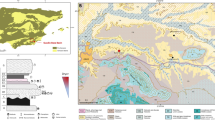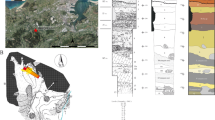Abstract
Multi-proxy analysis of the coprolites which were found during excavations at two Late Neolithic (fourth millennium bc) pile-dwelling sites (Črnelnik and Stare gmajne) in Slovenia yielded some new insights into human–dog relations and behaviour. The digested content is presented in a multidisciplinary approach, in which palynological, palaeoparasitological, archaeobotanical and archaeozoological features are studied and genetic signs are tested. Beside the origin of the coprolites, the size of an animal and the diet, the faeces provided some additional information, such as health, status, nutrition habits, environment and season.








Similar content being viewed by others
References
Akeret Ö, Jacomet S (1997) Analysis of plant macrofossils in goat/sheep faeces from the Neolithic lake shore settlement of Horgen Scheller—an indication of prehistoric transhumance? Veget Hist Archaeobot 6:235–239
Akeret Ö, Hass JN, Leuzinger U, Jacomet S (1999) Plant macrofossil and pollen in goat/sheep faeces from the Neolithic lake-shore settlement Arbon Bleice 3, Schwitzerland. Holocene 9:175–182
Andrič M, Kroflič B, Toman MJ, Ogrinc N, Dolenec T, Dobnikar M, Čermelj B (2008) Late Quaternary vegetation and hydrological change at Ljubljansko barje (Slovenia). Palaeogeogr Palaeoclimatol Palaeoecol 270:150–165
Ash LR, Orihel TC (2007) Atlas of human parasitology, 5th edn. American Society for Clinical Pathology Press, Chicago
Baeten J, Mees F, Marinova E et al (2018) Late Pleistocene coprolites from Qurta (Egypt) and the potential of interdisciplinary research involving micromorphology, plant macrofossil and biomarker analyses. Rev Palaeobot Palynol 259:93–111. https://doi.org/10.1016/j.revpalbo.2018.09.014
Bartosiewicz L (2002) Dogs from the Ig pile dwellings in the National Museum of Slovenia. Arheološki vestnik 53:77–89
Bennett KD, Willis KJ (2002) Pollen. In: Smol JP, Birks HJ, Last WM (eds) Tracking environmental changes using lake sediments. 3. Terrestrial, algal and siliceous indicators. Kluwer Academic Publishers, Dordrecht, pp 5–32
Bon C, Berthonaud V, Maksud F et al (2012) Coprolites as a source of information on the genome and diet of the cave hyena. Proc R Soc B 279(1739):2,825-2,830
Brönnimann D, Pümpin C, Ismail-Meyer K, Rentzel P, Egüez N (2017) Excrements of omnivores and carnivores. In: Nicosia C, Stoops G (eds) Archaeological soil and sediment micromorphology. Wiley, Hoboken, pp 67–82
Bryant VM, Dean GW (2006) Archaeological coprolite science: the legacy of Eric O. Callen (1912–1970). Palaeogeogr Palaeoclimatol Palaeoecol 237:51–66
Butler VL, Schroeder RA (1998) Do digestive processes leave diagnostic traces on fish bones? J Archaeol Sci 25:957–971
Byrne D (1973) Prehistoric coprolites: a study of human and dog coprolites from prehistoric archaeological sites in the North Island of New Zealand. Unpublished M.A. Thesis, University of Auckland, Auckland
Cappers RTJ, Bekker RM, Jans JEA (2006) Digitale Zadenatlas van Nederland (Digital seed atlas of the Netherlands). Groningen Archaeological Studies 4. Barkhuis Publishing, Groningen
Cohen A, Serjeantson D (1996) A manual for the identification of bird bones from archaeological sites. Archetype Publications, London
Delhon C, Martin L, Argant J, Thiebault S (2008) Shepherds and plants in the Alps: multi-proxy archaeobotanical analysis of Neolithic dung from »La Grande Rivoire« (Isere, France). J Archaeol Sci 35:2937–2952
Drobne K (1973) Favna koliščarskih naselbin na Ljubljanskem barju (Fauna der Pfahlbautensiedlungen auf dem Moor von Ljubljana). Arheološki vestnik 24:217–224
Dufour B, Le Bailly M (2013) Testing new parasite egg extraction methods in paleoparasitology and an attempt at quantification. Int J Paleopathol 3:199–203
Dunseth ZC, Fuks D, Langgut D et al (2019) Archaeobotanical proxies and archaeological interpretation: a comparative study of phytoliths, seeds and pollen in dung pellets and refuse deposits at Early Islamic Shivta, Negev, Israel. Quat Sci Rev 211:166–185
Ericsson PGP (1987) Interpretations of archaeological bird remains: a taphonomic approach. J Archaeol Sci 14:65–75
Govedič M (2004) Fishes from the archeological site at Hočevarica. In: Velušček A (ed) Hočevarica, an Eneolithic pile dwelling in the Ljubljansko barje. Opera Instituti Archaeologici Sloveniae, vol 8. Institute of archaeology at ZRC SAZU, Ljubljana, pp 133–151
Granadeiro JP, Silva MA (2000) The use of otoliths and vertebrae in the identification and size-estimation of fish in predator-prey studies. Cybium 24:383–393
Horrocks M, Irwin GJ (2003) Pollen, phytoliths and diatoms in prehistoric coprolites from Kohika, Bay of Plenty, New Zealand. J Archaeol Sci 30:13–20
Ismail-Meyer K, Rentzel P (2004) Mikromorphologische untersuchung der schichtabfolge. In: Jacomet S, Leuzinger U, Schibler J (eds) Die jungsteinzeitliche Seeufersiedlung von arbon bleiche 3: umwelt und wirtschaft archäologie im thurgau 12. Amt für Archäologie, Frauenfeld, pp 66–80
Janžekovič F, Malez V (2004) Birds (Aves) at the Eneolithic pile dwelling at Hočevarica. In: Velušček A (ed) Hočevarica, an Eneolithic pile dwelling in the Ljubljansko barje. Opera Instituti Archaeologici Sloveniae, vol 8. Institute of archaeology at ZRC SAZU, Ljubljana, pp 155–168
Jones AKG (1986) Fish bone survival in the digestive systems of the pig, dog and man: some experiments. In: Brinkhuizen DC, Clason AT (eds) Fish and Archaeology: studies in osteometry, taphonomy, seasonality and fishing methods BAR internat ser, vol 294. BAR, Oxford, pp 53–61
Križnar M, Kovalchuk OM (2016) Quaternary fish remains from Ljubljansko barje and Križna jama in the paleontological collections of the Slovenian Museum of Natural History; Summary (Ostanki kvartarnih sladkovodnih rib z Ljubljanskega barja in iz Križne jame iz paleontoloških zbirk Prirodoslovnega muzeja Slovenije). Arheološki vestnik 67:389–399
Kühn M, Maier U, Herbig C, Ismail-Meyer K, Le Bailly M, Wick L (2013) Methods for the examination of cattle, sheep and goat dung in prehistoric wetland settlements with examples of the sites Alleshausen-Täschenwiesen and Alleshausen-Grundwiesen (around cal 2900 bc) at Lake Federsee, south-west Germany. Environ Archaeol 18:43–57
Landau SY, Dvash L, Ryan P, Saltz D, Deutch T, Rosen SA (2020) Faecal pellets, rock shelters, and seasonality: the chemistry of stabling in the Negev of Israel in late prehistory. J Arid Environ 181:104219
Le Bailly M, Araújo A (2016) Past intestinal parasites. Microbiol Spectr. https://doi.org/10.1128/microbiolspec.PoH-0013-2015
Le Bailly M, Leuzinger U, Bouchet F (2003) Dioctophymidae eggs from coprolites from neolithic site of Arbon-Bleiche 3 (Switzerland). J Parasitol 89:1,073-1,076
Le Bailly M, Leuzinger U, Schlichtherle H, Bouchet F (2005) Diphyllobothrium: neolithic parasite? J Parasitol 91:957–959
Macphail RI (2000) Soils and microstratigraphy: a soil micromorphological and micro-chemical approach. In: Lawson AJ (ed) Potterne, 1982–5: animal husbandry in later prehistoric Wiltshire. Wessex archaeology report, vol 17. Wessex Archaeology, Salisbury, pp 47–71
Maicher C, Hoffmann A, Côté NML, Palomo Pérez A, Saña Segui M, Le Bailly M (2017) Paleoparasitological investigations on the Neolithic lakeside settlement of La Draga (Lake Banyoles, Spain). Holocene 27:1659–1668
Marinova E, Ryan P, van Neer W, Friedman R (2013) Animal dung from arid environments and archaeobotanical methodologies for its analysis: an example from animal burials of the Predynastic elite cemetery HK6 at Hierakonpolis. Egypt Environ Archaeol 18:58–71
Moore PD, Webb JA, Collinson ME (1991) Pollen analysis, 2nd edn. Blackwell Scientific Publications, Oxford
Reille M (1992) Pollen et Spores d’Europe et d’Afrique Du Nord. Laboratoire de Botanique Historique et Palynologie, Marseille
Reille M (1995) Pollen et Spores d’Europe et d’Afrique Du Nord (Supplement). Laboratoire de Botanique Historique et Palynologie, Marseille
Reinhard KJ, Bryant VM (1992) Coprolite analysis. A biological perspective on archaeology. In: Shiffer M (ed) Archaeological method and theory, vol 4. University of Arizona Press, Tuscon, pp 245–288
Reinhard K, Ferreira LF, Bouchet F et al (2013) Food, parasites, and epidemiological transitions: a broad perspective. Int J Paleopathol 3:150–157
Russell N, Twiss KC (2017) Digesting the data: dogs as taphonomic agents at Neolithic Çatalhöyük, Turkey. In: Mashkour M, Beech M (eds) Archaeozoology of the near east, vol 9. Oxbow Books, Oxford, pp 59–73
Schmid E (1972) Atlas of animal bones for prehistorians, archaeologists and quaternary geologists. Elsevier, Amsterdam
Skrbinšek T (2010) Navodila za sodelovanje pri raziskavi volkov s pomočjo genetike. Univerza v Ljubljani, Biotehniška fakulteta, Oddelek za biologijo, Ljubljana. https://www.volkovi.si/wp-content/uploads/2014/10/brosura-genetika-slowolf-web1.pdf
Smith A, Proctor L, Hart TC, Stein GJ (2019) The burning issue of dung in archaeobotanical samples: a case-study integrating macro-botanical remains, dung spherulites, and phytoliths to assess sample origin and fuel use at Tell Zeidan, Syria. Veget Hist Archaeobot 28:229–246. https://doi.org/10.1007/s00334-018-0692-9
Stockmarr J (1971) Tablets with spores used in absolute pollen analysis. Pollen Spores 13:615–621
Taylor MA, Coop RL, Wall R (2007) Veterinary parasitology. Blackwell Publishing, Oxford
Tolar T, Galik A (2019) A study of dog coprolite from Late Neolithic pile-dwelling site in Slovenia. Archaeol Discov 7:20–29
Tolar T, Jacomet S, Velušček A, Čufar K (2011) Plant economy at a late Neolithic lake dwelling site in Slovenia at the time of the Alpine Iceman. Veget Hist Archaeobot 20:207–222
Toškan B, Achino KF, Velušček A (2019) Faunal remains mirroring social and functional differentiation? The copper age pile-dwelling site of Maharski prekop (Ljubljansko barje, Slovenia). In: Francesca AK, Toškan B, Velušček A (eds) Depicting the past of Balkan and Appennine Peninsulas between Eneolithic and Bronze Age: artefacts and ecofacts as means of functional differentiation and social stratification. Quat Int 539:62–77. https://doi.org/10.1016/j.quaint.2019.01.028
Velušček A (2009) Stare gmajne pile-dwelling settlement and its era. Opera Instituti Archaeologici Sloveniae, vol 16. Institute of archaeology at ZRC SAZU, Ljubljana
Velušček A, Toškan B, Čufar K (2011) Zaton kolišč na Ljubljanskem barju. Arheološki vestnik 62:51–82
Velušček A, Podpečan B, Tolar T, Toškan B, Turk J, Merela M, Čufar K (2018) Črnelnik and Devce, newly discovered copper age sites at Ljubljansko barje. Arheološki vestnik 69:9–68
Vigne J-D (1995) Détermination ostéologique des principaux éléments du squelette appendiculaire d’Arvicola, d’Elyomis, de Glis et de Rattus. Fiches d’ostéologie animale pour l’archéologie, Série B: mammifères, vol 6. Centre de Recherches Archéologiques du CNRS, Valbonne
Wood JR, Wilmshurst JM (2016) A protocol for subsampling late quaternary coprolites for multi-proxy analysis. Quat Sci Rev 138:1–5
Wood JR, Crown A, Cole TL, Wilmshurst JM (2016) Microscopic and ancient DNA profiling of Polynesian dog (kurī) coprolites from northern New Zealand. J Archaeol Sci Rep 6:496–505
Zachary CD, Fuks D, Langgut D et al (2019) Archaeobotanical proxies and archaeological interpretation: a comparative study of phytoliths, pollen and seeds in dung pellets and refuse deposits at Early Islamic Shivta, Negev, Israel. Quat Sci Rev 211:166–185
Acknowledgements
The project is financed by the Slovenian Research Agency (SRA; Funding Nos. J7-2598; P6-0064 (B); J7-6857 and Young Research Program of the SRA). Many thanks to technical assistant Dragotin Valoh for preparing figures.
Author information
Authors and Affiliations
Corresponding author
Additional information
Communicated by M. Primavera.
Publisher's Note
Springer Nature remains neutral with regard to jurisdictional claims in published maps and institutional affiliations.
Electronic supplementary material
Below is the link to the electronic supplementary material.
Rights and permissions
About this article
Cite this article
Tolar, T., Galik, A., Le Bailly, M. et al. Multi-proxy analysis of waterlogged preserved Late Neolithic canine excrements. Veget Hist Archaeobot 30, 107–118 (2021). https://doi.org/10.1007/s00334-020-00805-y
Received:
Accepted:
Published:
Issue Date:
DOI: https://doi.org/10.1007/s00334-020-00805-y




